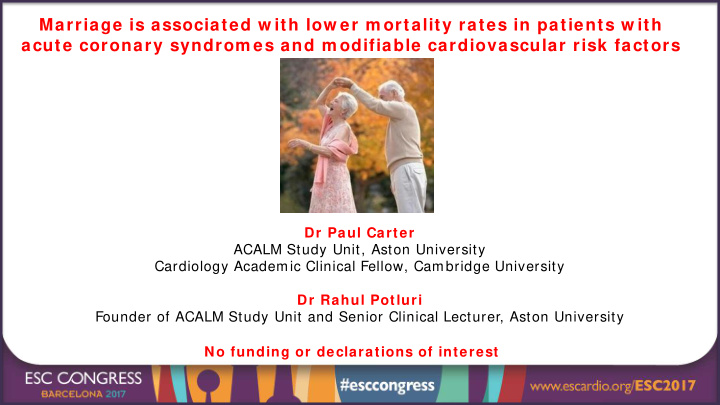



Marriage is associated w ith low er m ortality rates in patients w ith acute coronary syndrom es and m odifiable cardiovascular risk factors Dr Paul Carter ACALM Study Unit, Aston University Cardiology Academic Clinical Fellow, Cambridge University Dr Rahul Potluri Founder of ACALM Study Unit and Senior Clinical Lecturer, Aston University No funding or declarations of interest
Background • Ischaemic heart disease is the leading cause of mortality worldwide IHD is influenced by a wide range of biopsychosocial factors. • • Marriage has previously been associated with lower mortality rates. Modifiable cardiovascular risk factors account for a large • proportion of IHD, but the extent to which they are controlled is variable. • Sociodemographic factors, such as marital status, could play an important role in this undermanagement of risk factors.
Aim ‘’Does marital status affect survival rates in patients with the main risk factors for heart disease, and, in patients who have had a heart attack?’’
Key Points about Methods • Big data approach using ACALM (Algorithm for Co-morbidities, Associations, Length of Stay and Mortality) Study Unit • Of over 1 million patient s admitted to multiple hospitals in North West England over 14 year period between 2000-2014 we studied those with: – Hypertension – Hyperlipidaemia – Type 2 Diabetes – Acute Coronary Syndrome • Mortality rates were studied for patients of different marital statuses • Statistical analyses adjusted for age, gender, ethnicity and the top 10 contributors to mortality in the UK.
The Study Groups
Results: I m pact of Marital Status on Mortality Increased Mortality Reduced Mortality
Results: I m pact of Marital Status on Mortality Increased Mortality Reduced Mortality
Results: I m pact of Marital Status on Mortality Increased Mortality Reduced Mortality
Results: I m pact of Marital Status on Mortality Increased Mortality Reduced Mortality
Results: I m pact of Marital Status on Mortality 1 ) Reduced m ortality in m arried and w idow ed patients Married vs Single Patients Widowed vs Single Patients • Hypertension: 0.900 (0.868-0.933)*** • Hypertension: 0.973 (0.960-0.987)*** • Hyperlipidaemia: 0.836 (0.768-0.909)*** • Hyperlipidaemia: 0.966 (0.933-1.000) • Type 2 Diabetes: 0.860 (0.819-0.903)*** • Type 2 Diabetes: 0.965 (0.947-0.985)*** • Acute Coronary Syndrome: 0.863 (0.798-0.933)*** • Acute Coronary Syndrome: 0.959 (0.947-0.971) *** 2 ) I ncreased m ortality in divorced patients Divorced vs Single Patients Divorced vs Married Patients • Hypertension: 0.981 (0.953-1.009) • Hypertension: 1.085 (1.034-1.139)*** • Hyperlipidaemia: 0.956 (0.897-1.019) • Hyperlipidaemia: 1.087 (0.978-1.210) • Type 2 Diabetes: 0.943 (0.906-0.981)** • Type 2 Diabetes: 1.041 (0.972-1.114) • Acute Coronary Syndrome: 1.068 (1.063-1.073)*** • Acute Coronary Syndrome: 1.157 (1.041-1.287)*
Conclusions Marital status impacts mortality in patients with cardiovascular risk/disease 1) Married patients have significantly lower mortality rates: Protective effect across all conditions – – Ranges from 10% lower mortality in hypertension to 16% lower in hyperlipidaemia – Likely due to support in managing risk factors such as medication compliance, cardiac rehabilitation and living a healthier lifestyle – Marker of psychological support generally, and support in dealing with condition
2) Widowed patients have lower adjusted mortality rates – Likely benefit from similar protective support over a lifetime 3) Divorced patients with ACS and hypertension have higher mortality rates – Stressful life events/psychological illness are associated with CVD Marital status is a marker of psychosocial health. This should be considered and replicated in all patients with cardiovascular disease. Social support networks through friends, family or support groups could improve survival of patients with cardiovascular risk factors or disease.
Recommend
More recommend